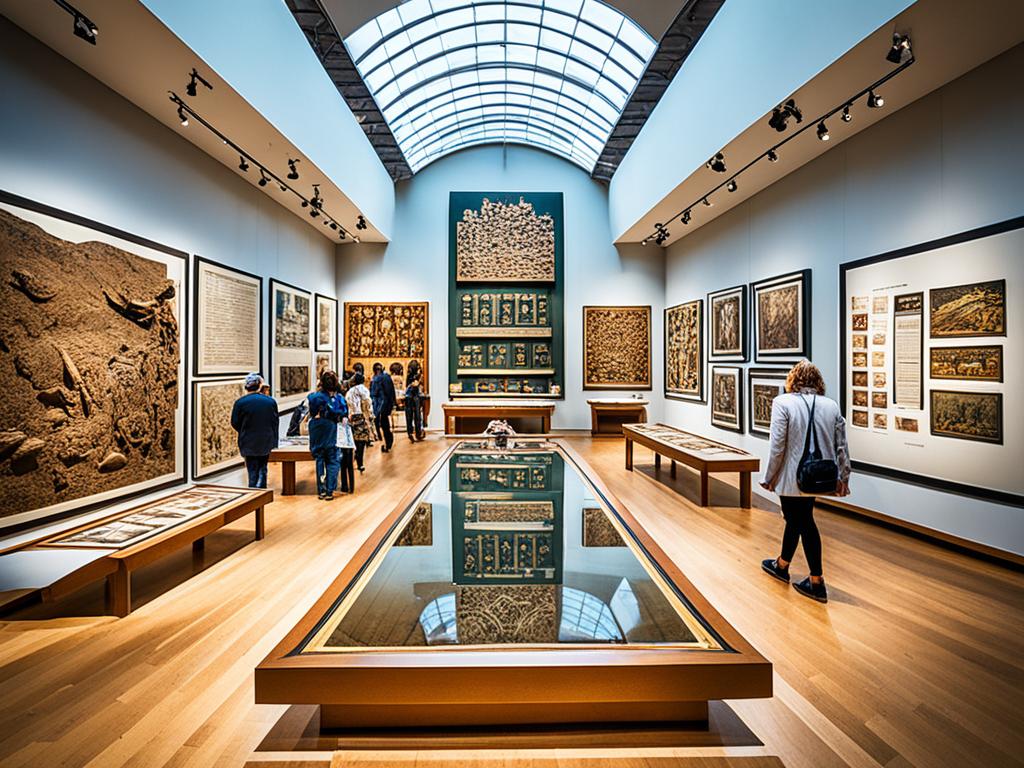Welcome to our article series on the vital role museums play in preserving cultural heritage. Museums serve as the custodians of our shared history, safeguarding artifacts and artworks that tell stories from the past. These cultural institutions not only showcase the richness and diversity of human creativity, but they also play a crucial role in educating and engaging visitors in a meaningful way.
In this article, we will explore the various facets of museums and their contribution to preserving cultural heritage. From their conservation efforts to their adaptation to the digital age, we will delve into how museums have evolved and continue to thrive as educational and inspiring spaces.
Key Takeaways:
- Museums are essential in preserving cultural heritage and serving as custodians of our shared history.
- These cultural institutions go beyond exhibition spaces to protect artifacts through conservation techniques.
- Adapting to the digital era, museums utilize technology to enhance accessibility and engagement with audiences.
- Education is a cornerstone of museums’ missions, which aim to inform and inspire visitors about cultural heritage.
- Through their efforts, museums ensure that the past is safeguarded and accessible for future generations.
Beyond Exhibition Spaces: Expanding Preservation Efforts
When you think of museums, you may envision grand exhibition spaces showcasing exquisite artifacts and artworks. However, museums are not just repositories of treasures from the past. They play a vital role in preserving the past: conservation techniques and challenges, going beyond the display of objects to ensure their long-term survival and accessibility for future generations.
Conservation techniques form the backbone of museums’ efforts to safeguard cultural heritage. Museum professionals employ a range of methods to preserve artifacts, including careful handling, environmental monitoring, and preventive conservation measures. These techniques aim to mitigate the effects of degradation caused by factors such as light exposure, temperature fluctuations, and pests.
One essential aspect of preserving cultural heritage is the proper storage and documentation of artifacts. Museums have dedicated storage facilities equipped with climate-controlled environments to protect delicate and sensitive objects. Additionally, thorough documentation, including detailed records and photographs, ensures the accurate cataloging and tracking of each artifact, facilitating research and future conservation efforts.
“Conservation is a delicate balance between preserving the integrity of an object and making it accessible to the public. It requires meticulous planning, expertise, and ongoing care.” – Dr. Emily Johnson, Head Conservator at the Metropolitan Museum of Art
Despite these efforts, museums face numerous challenges in maintaining and safeguarding their collections. Financial constraints often limit the resources available for conservation activities. Moreover, the inherent fragility of certain materials, such as organic textiles and delicate paintings, presents additional conservation challenges.
Furthermore, museums must navigate the complex ethical considerations surrounding conservation practices. Decisions regarding restoration and repair require careful deliberation to strike a balance between preserving an object’s authenticity and enhancing its visual appeal for visitors.
By going beyond traditional exhibition spaces, museums extend their preservation efforts to prioritize the long-term survival of cultural heritage. They aim to ensure that future generations can appreciate and learn from these invaluable artifacts. But, the conservation journey is an ongoing one, as new challenges arise and innovative techniques continue to evolve.
The Evolution of Museums in the Digital Era
The digital era has brought about significant changes in the way museums operate and engage with their audiences. Technology has transformed the traditional museum experience, opening up new avenues for the preservation and accessibility of cultural heritage.
One of the key advancements in museum evolution is the integration of digital platforms into their exhibits and collections. Museums now use interactive displays, virtual reality (VR) experiences, and mobile applications to offer visitors a more immersive and engaging experience. These technologies allow visitors to explore artifacts and artworks in innovative ways, providing a deeper understanding and connection to cultural heritage.
Furthermore, the digital era has enabled museums to overcome physical limitations and reach a global audience. Online platforms and virtual exhibitions make it possible for individuals from different parts of the world to access and appreciate cultural treasures. Through virtual tours, high-resolution images, and informative descriptions, museums create a digital space where anyone can explore and learn about cultural heritage.
“Technology has revolutionized the way museums preserve and present cultural heritage. Digital platforms help bridge the gap between the past and the present, making history come alive for people of all ages and backgrounds.” – Sarah Thompson, Curator of Digital Engagement
In addition to enhancing visitor experiences, digitalization has greatly contributed to the preservation of cultural heritage. Museums can now digitize their collections, creating digital archives that act as a backup and safeguard against loss or damage. This allows museums to safeguard important artifacts and artworks for future generations while making them accessible to researchers and scholars around the world.
Moreover, museums are utilizing social media platforms to engage with audiences and promote their exhibitions and events. Through Facebook, Instagram, Twitter, and other platforms, museums can share behind-the-scenes content, educational resources, and updates on new acquisitions. This not only attracts a wider audience but also encourages active participation and interaction, fostering a sense of community among museum enthusiasts.
| The Evolution of Museums in the Digital Era |
|---|
|
The evolution of museums in the digital era has revolutionized the way cultural heritage is preserved, presented, and accessed. Through the integration of technology, museums have expanded their reach, captivating audiences worldwide and ensuring the longevity of our shared history.
Educational Missions: Engaging and Inspiring Visitors
Museums play a vital role in not just preserving cultural heritage but also in educating and inspiring visitors. With their educational missions, museums aim to engage audiences and foster a deeper understanding and appreciation of our shared history and culture.
One of the key approaches museums take to fulfill their educational missions is by offering informative and interactive experiences. Through carefully curated exhibitions, museums provide a platform for visitors to explore and learn about different aspects of cultural heritage. These exhibitions showcase artifacts, artworks, and historical objects, offering a glimpse into the rich tapestry of human history.
Moreover, museums often employ innovative technologies to enhance the educational experience. From interactive touchscreens and virtual reality exhibits to immersive audiovisual presentations, these advancements enable visitors to engage with the exhibits in a dynamic and immersive manner. By leveraging technology, museums can bring the past to life and create memorable learning experiences for visitors of all ages.
“Museums have the power to transform education by making learning enjoyable and interactive.”
Furthermore, museums recognize the importance of catering to diverse audiences. They strive to create inclusive spaces and develop programs and initiatives that cater to different learning styles and interests. This includes educational workshops, guided tours, and interactive activities that encourage active participation and engagement.
Through these initiatives, museums aim to not only educate but also inspire visitors. By presenting cultural heritage in a relatable and engaging manner, museums spark a sense of curiosity and wonder in visitors. Whether it’s through exploring ancient artifacts, discovering untold stories, or engaging with hands-on activities, museums cultivate a lifelong passion for learning and appreciation for cultural heritage.
Preserving the Past for Future Generations
As custodians of cultural heritage, museums play a vital role in preserving the past for the benefit of future generations. Through the use of conservation techniques and challenges, these institutions ensure that our collective history remains intact and accessible for years to come.
One of the primary challenges museums face in preserving the past is the conservation of fragile artifacts and artworks. These objects, often susceptible to the ravages of time, must be treated with utmost care and expertise. Museum conservators employ a variety of techniques, such as careful handling, temperature and humidity control, and specialized treatments, to slow down the natural deterioration processes and preserve these invaluable treasures.
Moreover, museums face the constant challenge of balancing the need for preservation with the desire to make cultural heritage accessible to the public. Conservation techniques should not hinder visitors’ ability to engage with and appreciate the artifacts. Thus, museums employ innovative methods, such as exhibition design, lighting, and interactive displays, to strike a delicate balance between preservation and public access.
“Preserving the past is not merely a responsibility; it’s a testament to our dedication to future generations, ensuring that they can connect with their roots and understand the world that came before them.” – Dr. Emily Patterson, curator at The National Museum of History
Beyond physical artifacts, museums also take up the challenge of preserving intangible cultural heritage. This includes traditions, practices, and rituals that are passed down through generations. By documenting and showcasing these elements, museums contribute to the continuity and appreciation of cultural practices that might otherwise fade away with time.
Moreover, the digital era presents new opportunities and challenges for preserving the past. Museums are embracing technology to digitize their collections, creating virtual exhibits and digital archives that can be accessed by a global audience. The digitization of cultural heritage allows for its preservation and widespread dissemination without compromising the integrity of the original artifacts.
The Role of Museums in Education and Awareness
By preserving the past, museums not only safeguard our cultural heritage but also serve as educational institutions. Through engaging exhibitions, curated tours, and educational programs, museums inspire visitors to learn about and appreciate the diverse cultures that shaped our world. They provide a platform for dialogue, understanding, and empathy, fostering a sense of belonging and shared humanity.
Moreover, museums also contribute to research and scholarship, collaborating with academics and experts to deepen our understanding of the past. Through rigorous study and analysis, museums contribute to the advancement of knowledge and the interpretation of history.
Facing the Future Together
Preserving the past for future generations is a collective effort that requires ongoing dedication and collaboration. Museums, in partnership with communities, governments, and individuals, serve as guardians of our shared heritage. They ensure that the stories of our ancestors are not forgotten, and that the lessons they hold continue to shape our present and inspire our future.
Conclusion
Throughout this article, we have explored the essential role of museums in preserving cultural heritage. Museums serve as the guardians of our shared history, taking on the responsibility of protecting and showcasing valuable artifacts and artworks for future generations to appreciate.
By going beyond their traditional exhibition spaces, museums employ various conservation techniques to safeguard the past. However, they also face challenges in maintaining and preserving these treasures, such as environmental factors and limited resources.
As we move further into the digital era, museums have evolved to embrace technology, enhancing the accessibility and engagement of cultural heritage. From virtual exhibitions to interactive experiences, these institutions continue to innovate and reach wider audiences worldwide.
Ultimately, museums have educational missions at their core, aiming to engage and inspire visitors. By providing informative and interactive experiences, museums create opportunities for individuals to learn about and connect with the rich tapestry of our cultural heritage.
In conclusion, museums play a vital role in preserving cultural heritage. Their ongoing efforts not only protect our past but also shape our future by instilling a sense of appreciation and value for our collective history in future generations. Let us continue to support and celebrate museums as they fulfill their important role as protectors and storytellers of our cultural legacy.







